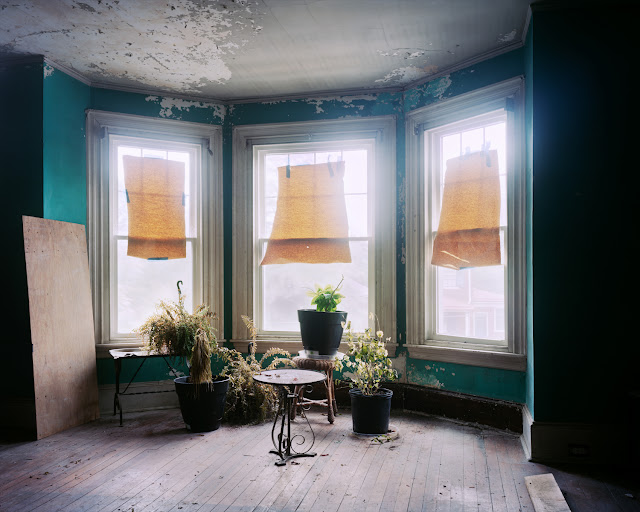 |
You can call me Nana. By Will Harris.
|
Photographs by Will Harris
Overlapse, 2021. 96 pp., 120 illustrations, 6¾x8½".
Will Harris’ You Can Call Me Nana charts the life of his beloved grandmother, Nana Evelyn — and her decline from Alzheimer’s — through a critical reinvention of the photo album. The book features an array of images, including an archive of family photographs, contemporary photographs made by Harris, tipped-in recipe cards, and a mid-century advertisement for prefabricated homes. The snapshots chronicle moments from her childhood, marriage and family life, to the building of her home in Mount Laurel, NJ with her husband Bill. Evelyn’s kind and playful spirit is keenly felt in these images, her warmth radiating in a megawatt smile. Throughout the book, hand-written texts detail conversations between Harris and Evelyn, giving a voice to the shifting, intimate terrain of their relationship.
Did they ever call you Nana?I’m not Nana, I’m Evelyn.Okay. Is it ok if I call you Nana?Banana?No. Just Nana.Why?Because. That’s what I’ve always called you. I’ve always called you Nana.Alright. Nana will be alright.
 |
A photo album typically imagines the life of an individual or family as a linear, progressive story, marked by documenting rites of passage. Dispensing with chronological order, Harris wreaks havoc with the album’s narrative conventions. The photographs loop in affective rhythms that are deeply attuned to the contingencies of memory and the experience of grief. Everything feels present and departed at once. An archive, by definition, is always incomplete, subject to omission or loss, and Harris mines these blind spots with great resonance in his account of Evelyn’s life and illness.
Harris deftly interrogates the surfaces and meanings of photography’s materiality in canny juxtapositions of analog and digital imagery. The notion of witness shares space with invention and they are granted equal authority in the project of mourning.
The book’s dusty blue cover features a black and white, 1950s-era studio portrait of a Black woman affixed with photo corners. Reminiscent of a yearbook picture, her face breaks down from analog grain into crude, blocky pixelation. His attention to the vulnerability of photographs echoes Evelyn’s memory loss, as if to say a photograph is a body too: holding joy and sorrow, subject to the tolls of living, a reserve of history in the process of disappearing.
Forsaking fetishistic nostalgia, Harris places the soft, cracked surfaces of paper emulsion alongside digitally altered family photographs. Altered doesn’t convey the emotional impact of these photographs. They are wounded and they haunt: eyes are erased; heads decapitated; figures dissipate, repeat, and layer. These manipulated images correspond with a series of black-and-white portraits of Evelyn, where she appears as a ghost-like figure, doubled and disappearing. Photographed while eating a meal at a dining room table, Evelyn’s head vanishes, rendered a white orb-like aperture, during the camera’s lengthy exposure. This hole in the picture, another wound. I imagine Harris’ hands shaking while making the photographs, rattled by the nervous impulses of his own body, his subjects blurring.
 |
Interspersed throughout the book are color photographs of his great grandmother Irene’s Victorian house in Philadelphia, where he currently lives. The colors are muted — an apt melancholic palate — with moments of vivid color; a wall peeling strips of white and teal paint, its chips pooling on the floor. An analogue clock radio on a bedstand is caught mid-roll between 6:56 and 6:57. Family members are absent from these photographs, but traces of them are scattered throughout the ancestral home: a blue chambray dress hanging on a closet door; a framed photograph of Evelyn stationed on a dresser. It’s unclear whether we’re seeing details of Irene’s life or Evelyn’s or Harris’s. The images depict the present state of the house and hint at the vertiginous experience of remembrance within its walls.
In his closing essay, Harris writes with devastating clarity, “I can truly say I know what it means to be forgotten.” You Can Call Me Nana ricochets between the temporal registers of loss across generations, staging memory on the fault lines of photography’s frailties.
Purchase Book
Read More Book Reviews
Purchase Book
Read More Book Reviews
 |
 |
Laura Larson is a photographer, writer, and teacher based in Columbus, OH. She's exhibited her work extensively, at such venues as Art in General, Bronx Museum of the Arts, Centre Pompidou, Columbus Museum of Art, Metropolitan Museum of Art, Museum of Fine Arts, Houston, SFCamerawork, and Wexner Center for the Arts and is held in the collections of Allen Memorial Art Museum, Deutsche Bank, Margulies Collection, Metropolitan Museum of Art, Microsoft, Museum of Fine Arts, Houston, New York Public Library, and Whitney Museum of American Art. Hidden Mother (Saint Lucy Books, 2017), her first book, was shortlisted for the Aperture-Paris Photo First Photo Book Prize. Larson is currently at work on a new book, City of Incurable Women (forthcoming from Saint Lucy Books) and a collaborative book with writer Christine Hume, All the Women I Know.










